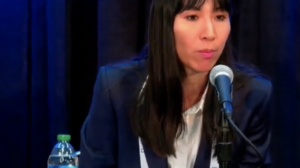NEW YORK (Reuters Health) – In a phase 2 study of patients with diabetic macular edema (DME), intravitreal injections of the vascular endothelial growth factor inhibitor, VEGF Trap-Eye, proved superior to macular laser treatment, researchers report.
“The results of this clinical trial,” they say, “provide additional support for the hypothesis that VEGF plays an important role in the pathogenesis of DME and suggests that VEGF inhibition may become of increasing importance in future treatment of DME.”
DME is the most common vision-threatening manifestation of diabetic retinopathy, note Dr. Diana V. Do, from the Wilmer Eye Institute, Johns Hopkins University in Baltimore, Maryland and colleagues in a report published online May 5 in Ophthalmology.
The anti-VEGF drugs ranibizumab (Lucentis) and bevacizumab (Avastin), both from Roche Holding AG, have recently been shown to be effective in reducing swelling in the retina and improving vision in these patients, they point out.
The trial by Dr. Do’s team involved VEGF Trap-Eye from Regeneron Pharmaceuticals and Bayer Healthcare Pharmaceuticals, which sponsored the trial.
VEGF Trap-Eye, the researchers say, has theoretic advantages over ranibizumab and bevacizumab including a longer half-life in the eye and a higher binding affinity to VEGF-A. In addition, this recombinant fusion protein binds placental growth factors 1 and 2, which have been shown to contribute to excessive vascular permeability and retinal neovascularization.
In an earlier phase 1 study, VEGF Trap-Eye improved visual acuity and reduced excess retinal thickness in 5 eyes with DME. Primary results from the phase 2 “DA VINCI study” support the phase 1 data. This 52-week international randomized, double-masked, active-controlled study compared different doses and dosing regimens of intravitreal VEGF Trap-Eye with focal/grid photocoagulation.
The study enrolled 221 diabetic patients with clinically significant DME involving the central macula at 39 sites in the United States, Canada, and Austria. Patients were assigned to one of five treatment arms: 0.5 or 2 mg VEGF Trap-Eye every 4 weeks; 2 mg VEGF Trap-Eye for 3 initial monthly doses and then every 8 weeks; 2 mg VEGF Trap-Eye for 3 initial monthly doses and then as needed; or macular laser photocoagulation.
Mean change in visual acuity, based on the number of letters a patient could read from the Early Treatment Diabetic Retinopathy study (ETDRS) charts, and central retinal thickness at 24 weeks were the main outcome measures.
According to the investigators, VEGF Trap-Eye led to significantly better mean visual acuity outcomes compared with laser therapy (+8.5 to 11.4 letters gained vs +2.5 letters gained). The P value was less than or equal to 0.0085 for each VEGF Trap-Eye group versus laser.
VEGF Trap-Eye also led to significantly greater mean reductions in retinal thickness (-127.3 to -194.5 micrometer vs -67.9 in the laser group). The P value was equal to 0.006 for each VEGF Trap-Eye group versus laser.
Moreover, different doses of VEGF Trap-Eye (0.5 or 2.0 mg) and dosing regimens (every 4 weeks, every 8 weeks or as needed) were all individually superior to laser and resulted in statistically significant increases in visual acuity and reductions in retinal thickness at 24 weeks, the researchers report.
This suggests that it may be possible to prolong the retreatment interval from 4 weeks to 8 weeks, the researchers say. They also note that when individual patient outcomes are considered, “the 2 mg dose almost completely eliminated vision loss at all dosing intervals.”
Local adverse events in patients treated with VEGF Trap-Eye were “generally consistent with those seen with other intravitreal anti-VEGF agents,” they say, and there were “no significant safety signals.”
The study was sponsored by Regeneron Pharmaceuticals, Inc., of Tarrytown, New York. Several of the studies authors have received financial relationships with Regeneron and/or other pharmaceutical companies.
Ophthalmology 2011.




